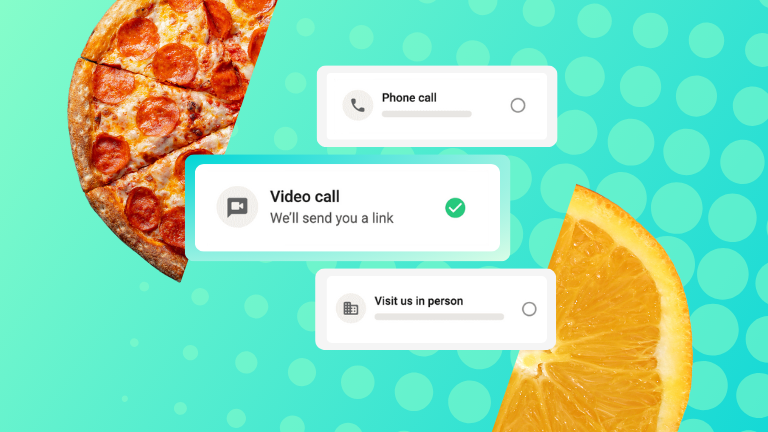Queue Management in Banks: The Top Trends and Tools to Know

Banks have always served a high volume of clients on a daily basis, but that volume is growing exponentially as more financial institutions adopt virtual services. Yet most banks haven’t updated their waiting/queue system to keep up with the times.
The result? Customers get frustrated by long lines, outdated tools, and the lack of transparency surrounding wait times. Likewise, staff members feel overburdened by inefficient booking processes, packed schedules, and unpredictable queues.
In short, if you still have a single roped line leading customers to a desk of generalists, it’s time for an update. Consumer demand calls for a more modern, streamlined, and efficient approach to queue management. So how do you get started?
In this article, we’ll outline everything you need to know about queue management in banks, from pros and cons to choosing and setting up the right system for your needs.
What Is a Queue in Banking? And Why Is Queue Management Important?
Also known as customer flow management, a traditional bank queue is a physical line of customers waiting for service at your physical branch location. With this method, the only way for customers to hold their spot in line is to stand there and wait. Customers typically have no idea how long it will take to get through the line, and they don’t know how many people will be waiting when they show up.
But these days, in-person lines are only one type of bank queue. Online queues for service and appointment requests offer an efficient, convenient way for customers to claim their spot in line while they go about their day.
Banks that manage to integrate in-person and online queues help improve the customer experience and staff efficiency. How? By preventing missed connections and quickly leading people to the services they’re looking for, which keeps staff and customers happy.
The Importance of Queue Management in Banks
In today’s highly competitive industry, a modern approach to queue management in banks is vital for success. Nearly half of banks (48%) are prioritizing implementing new technologies across all their branches. So banks that don’t get on board with this trend are practically giving their customers away to competitors.
The fact is, today’s consumers are demanding the convenience of online queuing systems, and banks that offer them eliminate friction and build customer loyalty.
Case in point: 72% of banking customers prefer the online appointment scheduling experience, but only 23% say their bank or credit union provides this method of engagement.
How Do I Manage My Queue? The Pros and Cons of Each Type of Queue Management
These days, queue management in banks comes in all shapes and sizes. Since no two financial institutions are alike, it’s important for banks to research options and find the right tool for their needs.
Let’s highlight a few of the most popular types of queuing, along with the pros and cons of each:
First Come First Served In-Branch Queuing
Most banks use a “first come first served” approach. This method works okay for in-person queue management, but it also deals with every customer’s needs in the same way. It doesn’t matter if the customer needs a specialist or a generalist — they’re all treated the same and all face the same wait times.
With this setup, customers may not get to see the specialist they need that day, and they might have to come back another day or wait for long periods of time to get the help they’re looking for. This approach doesn’t offer a way for banks to track in-person traffic, either, so it’s difficult for staff to improve customer service.
In-Branch Fast Lanes
Some banks have attempted to improve the “first come first served” strategy to queue management by offering in-branch “fast lanes.” This separates customers into one of two categories: customers who have a general request, and customers who have a business inquiry or cash request.
These optional lanes are definitely a step in the right direction, but they still miss out on serving the virtual needs of the modern customer. This model doesn’t allow for pre-booked appointments, or one-time service appointments that need more than a bank teller. Customers don’t have the option of self-service, and there still isn’t much visibility for banks to improve queue management strategies.
Digital Check-Ins
When banks are looking to modernize their queue management, many of them first turn to digital check-ins. These tools allow customers to check in on a tablet or computer system when they arrive at the branch, eliminating the need for a physical line.
And while digital check-ins are another step toward efficiency and improved tracking, they still fall short of true change. This approach simply doesn’t have the bandwidth to drastically improve the customer experience, speed, self-service experience, etc. Digital check-in tools don’t tie into CRMs or other larger appointment or traffic tracking systems, so banks still don’t have the data needed to affect change.
Hybrid, Self-Service Queues
Self-service hybrid queue software is the new ideal for modern queue management. These models allow customers to access the queue in-branch and online, so they can check wait times or claim a spot in line from wherever they are. Customers can join a line or leave a line, request an online call, or book an appointment in-person. Whatever they prefer, they have the freedom, flexibility, and visibility to make it happen.
Hybrid, self-service queues offer bank management and staff more freedom and visibility, too. Improved analytics and tracking empower staff members so they’re more efficient and prepared to serve customers, without feeling burned out or overbooked.
What Are the Benefits of Queue Management?
The best queue management systems for banks are expansive, flexible, and easy to integrate with existing systems. An individual kiosk or sign-in tool simply isn’t enough to meet the needs of the modern customer. Instead, banks need a full queue management system that includes queuing, online accessibility, in-brach accessibility, and appointment booking.
✅ Get a better understanding of branch traffic volume
✅ Accurately display live wait times (in-person and online)
✅ Improve customer satisfaction with self-serve options and “next in line” notifications
✅ Give your staff a central view of who is in the queue, what services they need, and how long they’ve been waiting
✅ Sort customers and members into the queue based on their needs by gathering information upon check in (do they have a simple cash request, or is it something more complicated that requires an advisor?)
These are just a few of the benefits of the latest hybrid, self-service queue tools. Give customers a more streamlined, quality banking experience, and enable your staff members to be more efficient and effective.
Improved Customer Experience
A self-service queue management system can calculate highly reliable wait times based on pre-booked appointments, staff calendars, branch traffic, and other important factors.
This means customers know exactly how long it’ll take to see a staff member and can decide the most convenient engagement method — waiting in line, filling out a callback request, scheduling an appointment, seeing their place in line on a lobby TV, or using a self-service kiosk or ATM.
Manage Foot Traffic & Scheduled Visitors
The best queuing systems eliminate friction in the lobby by allowing customers to view real-time availability and join the appropriate queue right away, whether they’re joining from their mobile device at home, waiting in their car, or physically in the branch.
Customers can indicate when they’ve arrived for their appointment, which triggers an instant notification to staff members and improves communication while decreasing wait times.
This is great news for banks, since 20% of customers who abandoned a busy lobby will rebook when they’re sent a missed notification. It’s great news for overburdened staff members, too — queue management systems reduce worries about foot traffic and make it easy to ensure staff coverage matches the flow of customers.
Gain Visibility Into Data for Location Traffic
You can’t manage what you can’t measure. With the right queue management system, banks get a complete, real-time view of location data to smooth foot traffic spikes based on staff availability, engagements, wait times, and more.
Banks can track and measure location and staff performance, as well as operations metrics like average handle times, wait times, and foot traffic per service. If your branch regularly has high wait times, you can make more informed decisions on operational improvements and then evaluate performance.
Other Benefits of Queue Management
In 2022, 68% of people abandoned the digital onboarding process for a banking product due to poor user experience. Luckily, an efficient queue management system can help recapture revenue opportunities by fostering stronger connections with clients.
Here are just a few more benefits of queue management software for banks:
- Fewer missed connections
- Increased operational efficiency
- Meet digital innovation demands
- Better insights across customer journeys
- Staffing optimization
- Increased bookings for products and services (mortgages, loans, financial investments)
- Better close rates
- Reduced no-shows and cancellations

Leveling Up Your Bank Queue Management Game
Digital and self-service tools are the way of the future for financial institutions, but it’s important to carefully consider how to best adopt these tools to maximize efficiency and effectiveness. By choosing a tool that’s comprehensive, intuitive, and easy to integrate with existing systems, institutions can ensure a smooth transition to the modern world of banking.
It’s also important to remember that physical branches still play a key role in the banking customer experience. People want the option to pop in and speak to a specialist in-person — but they also want the flexibility and convenience of virtual tools.
By leveraging the power of a hybrid queue management solution, banks can meet the needs of all customers, improve staff efficiency, and stay competitive in an ever-evolving industry.
Request a demo or check out our experience ebook today to learn how Coconut Software can help bring your institution into the modern age of bank queue management.





